In 1881 the Dover Telegraph reported on the proof trials of the turret’s No.2 gun. At first it was proposed to move the guns to Dover by rail, but this was considered to be too costly as a special carriage would be needed that would be useless for anything else. Eventually it was decided to move the guns by barge and use special sheers and holdfasts as anchors. The guns were lifted by manpower with a capstan instead of by machinery, permission being granted for this by the Board of Trade on condition that it all be removed as soon as possible after the guns were landed. An overhead traveller was constructed to move the guns across to the top of the turret and then lower them onto their carriages. The sheers weighed 100 tons and the traveller weighed 22 tons.
They were tested in 1881 and the No.1 gun arrived on 4 December 1881. It was in place by 6 January 1882. The No.2 gun followed on 12 May 1882. The turret machinery was ready for testing at the beginning of 1883 and the testing was arranged for July. The first shot was fired using a 250 pound charge. A second shot followed using a 337 pound charge and finally three shots were fired using a full battering charge of four hundred and fifty pounds of powder. The cliffs did not fall down as predicted, and neither did the fort itself but a couple of panes of glass were broken in the nearby lighthouse. By 1884 more experiments at Dover Turret had taken place with the electric lighting of the turret and the firing gear of the two guns. In 1885 the pierhead had been extended landward and within this a new shell store, a coal bunker and a new cartridge store were built. In 1886 the committee assembled at the turret to watch the guns being fired. Four rounds were fired and the committee reported that the turret was ready to be handed over to the Royal Artillery.
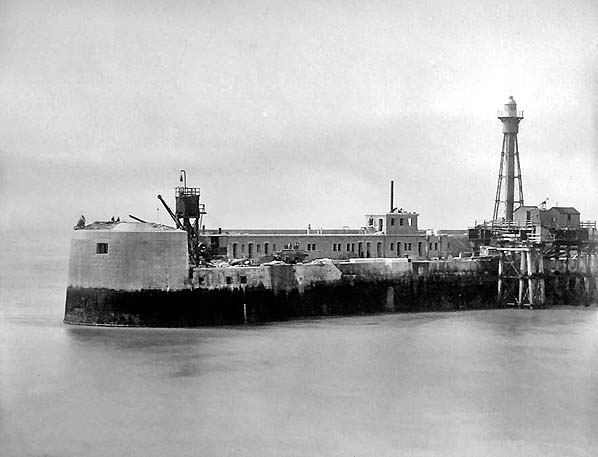 Pier extension in August 1907 during the construction of the Pier extension battery. The signal station is seen on top of the accommodation buildings.
Pier extension in August 1907 during the construction of the Pier extension battery. The signal station is seen on top of the accommodation buildings.
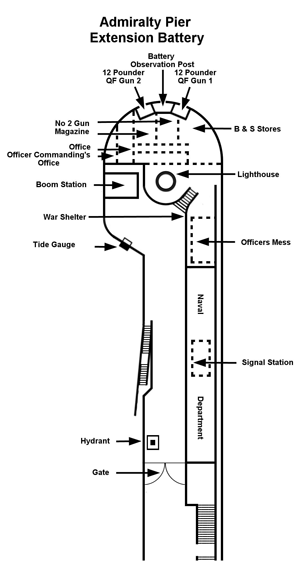
In 1887 a consultative committee decided that the efficiency of the two 81-ton guns in the Dover Turret was diminished by the exposed position of the magazine. It was proposed to make a new shell store below the water line and to increase the thickness of the foundation of the turret with a mass of concrete. In 1891 the Dover Harbour Board wished to extend the pierhead to the seaward and to give it a more rounded shape owing to erosion by the rip tide. In 1893 the committee reported that the works for strengthening the magazines of Admiralty Pier Fort were nearing completion.
A report of May 1886 stated that the Admiralty Pier had no defences of its own. Two 6in B.L. guns were added on top of Admiralty Pier Fort either side of the turret by April 1909. This was named ‘Pier Turret Battery’. The shell stores beneath the old turret were used to store ammunition for the new battery with shell lifts driven through the roof to each gun. Searchlights were added on the parapet of the pier. By this time the pier had been widened to allow construction of the pier extension. The guns installed in the battery were BL 6in Mk VIIs, one from Woolwich and one from South Front Battery. The battery was handed over to the Royal Artillery on 23 June 1909. A battery command post was added on top of the old lighthouse which was no longer used as a new one had been built at the end of the Admiralty Pier extension.
Between 1898 and 1909 Admiralty Pier was extended by a further 2000ft as the western arm of Admiralty Harbour. A second battery known as the ‘Pier Extension Battery’ was built to defend Dover Harbour from enemy shipping. It was constructed between 1905 and 1910 and armed with two 12 pounder quick fire (QF) naval guns with a range of 11,750yd. Both this battery and the Pier Turret Battery were armed in 1910. The Admiralty Harbour was designed to provide a protected anchorage for the naval fleet and increase the protection of the existing commercial harbour.
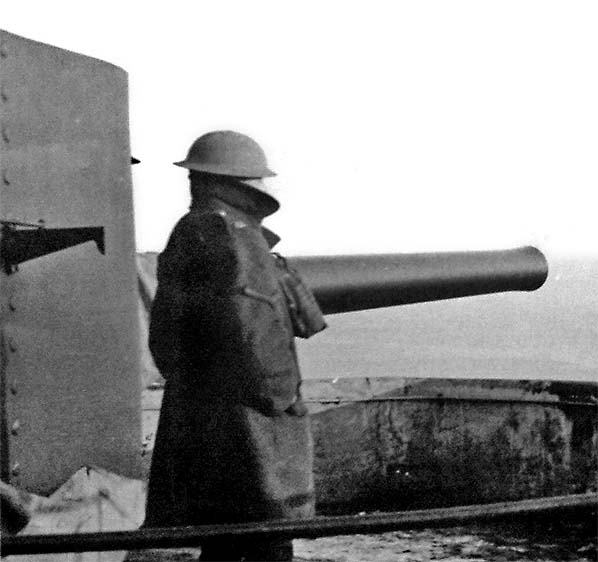 One of the 6in breech-loading guns emplaced on top of the turret as part of Pier Turret Battery.
One of the 6in breech-loading guns emplaced on top of the turret as part of Pier Turret Battery.
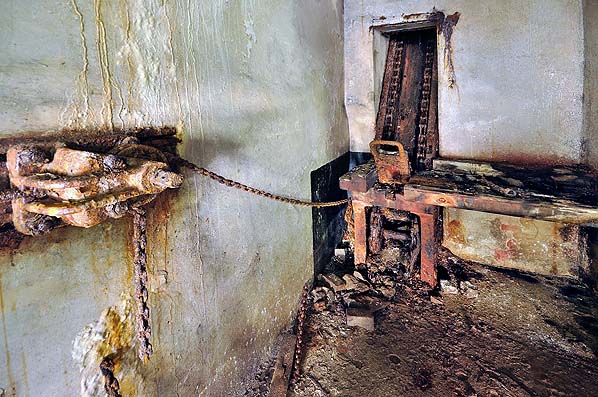 Surviving ammunition lift for one of the 6in BL guns.
Surviving ammunition lift for one of the 6in BL guns.
Photo from Nik24's Flickr Photostream
Between the two World Wars the Admiralty Pier Fort was transformed into a home for the battery caretaker, who lived there with his wife and family. The guns remained in place inside the turret. In 1920 the Pier Turret Battery was reduced to ‘care and maintenance’ but was used for drill by the Territorial Army. In April 1944 the battery became Home Guard Battery. According to the Fort record book the guns were withdrawn to Woolwich in August 1947. In 1958 all of the battery buildings at Admiralty Pier Fort were demolished and the two BL 6in emplacements tidied. One became a shelter and the other a small viewing platform. The fort itself and the turret remained. After a severe storm in 1987 the walkway along the pier was closed and the turret became inaccessible to the public. Most of the machinery inside the turret has been removed but the guns and their carriages remain together with parts of the shell lifts for the BL 6in guns above. The turret remains under the control of Dover Harbour Board and there are no plans to restore it or open it to view.
Originally situated at the end of the western breakwater, the main turret is now part-way along, after the breakwater was extended in 1897. It can be viewed from the adjacent Prince of Wales Pier for free in daylight hours.
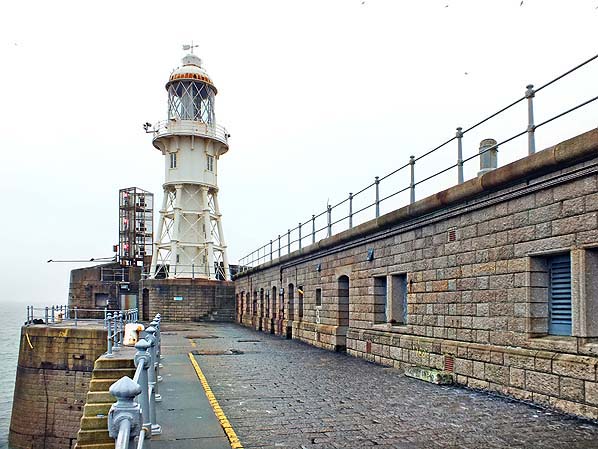 Pier Extension Battery is largely intact with most of the buildings surviving. This view is from April 2014. The pier extension is not accessible to the public.
Pier Extension Battery is largely intact with most of the buildings surviving. This view is from April 2014. The pier extension is not accessible to the public.
Photo by Paul Wells from his Dover Past Flickr Photostream containing 15,177 pictures of Dover.
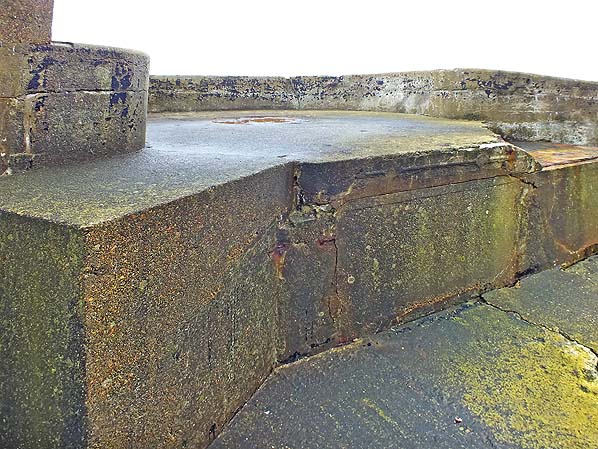 One of the 12 pounder QF gun emplacements on the Pier Extension battery.
One of the 12 pounder QF gun emplacements on the Pier Extension battery.
Photo by Paul Wells from his Dover Past Flickr PhotostreamIn 1926 Admiralty Harbour was recognized as having limited military use and it was decided to hand it, including the Admiralty Pier, to the Dover Harbour Board for administration as a commercial undertaking. All ordnance was removed from the pier in 1944 and the military store and accommodation buildings around the turret were demolished in 1958. Some remains of Pier Turret Battery survive, with No.1 gun emplacement having a refreshment kiosk built into it and No. 2 emplacement as a viewing platform. Pier Extension Battery remains better preserved with the emplacements and crew quarters surviving but there is no public access to the pier beyond the turret.
Source: Wikipedia - Admiralty Pier Turret. Text and plan copied under creative commons licence
Additional reading :
Turret Widening Photos: 1900 - 1910



